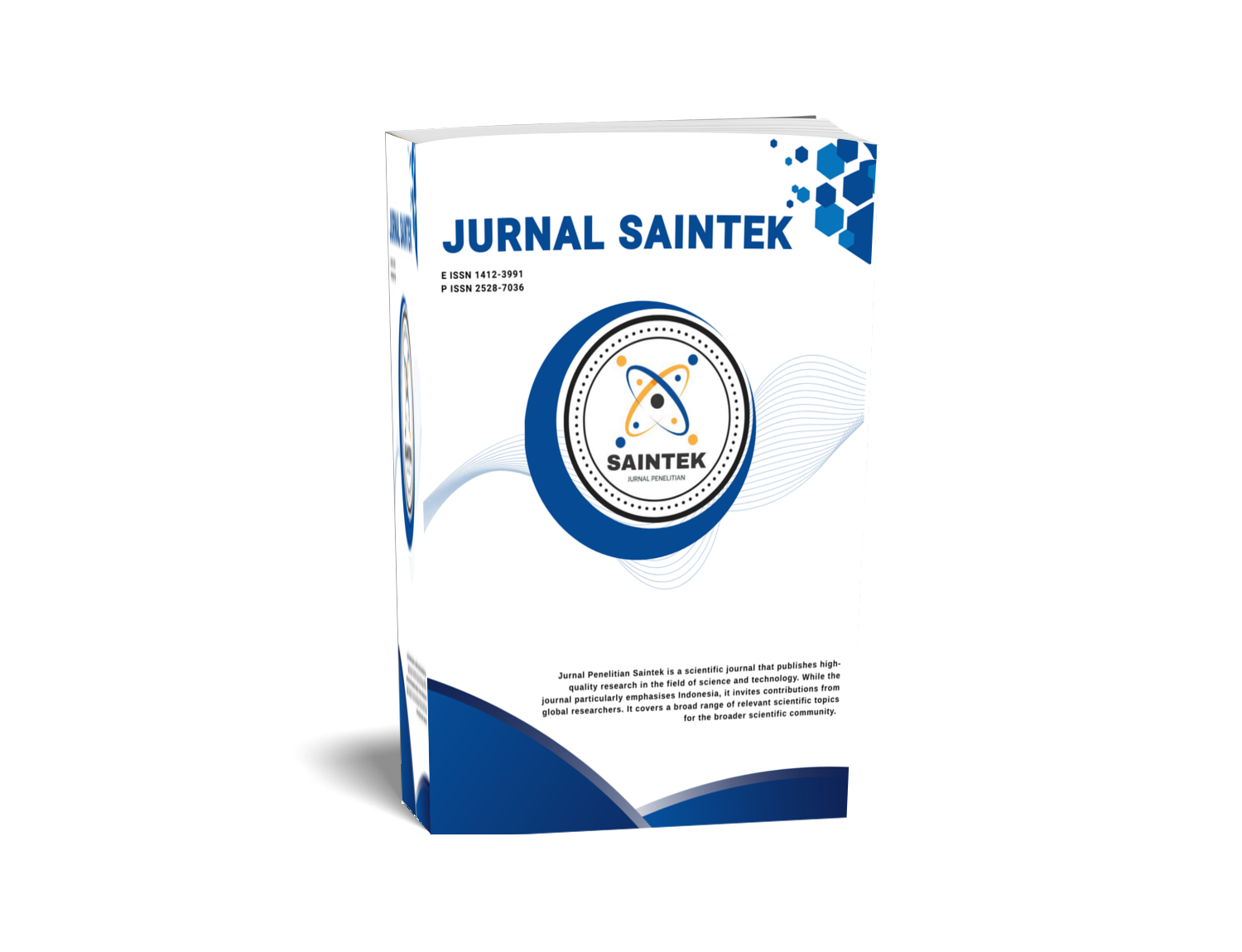Aplikasi variasi jumlah pelat elektroda Al-Fe pada pengurangan mikroplastik dalam limbah masker secara elektrokoagulasi
DOI:
https://doi.org/10.21831/jps.v1i2.67098Abstract
Penelitian ini bertujuan untuk mengetahui pengaruh jumlah pelat elektroda Fe-Al pada pengurangan mikroplastik dalam limbah masker secara elektrokoagulasi. Sampel penelitian adalah limbah masker medis. Masker dipotong-potong dengan ukuran 1-5 mm. Potongan masker tersebut direndam dalam aquades selama 7 hari. Cairan yang mengandung mikroplastik dielektrokoagulasi dengan kombinasi pelat elektroda (Al-Fe), (Al-Fe-Al), dan (Al-Fe-Al-Fe) selama 4 jam, arus listrik 2,5 A dan pH 6,0. Serat mikroplastik sebelum dan sesudah elektrokoagulasi diamati dengan mikroskop perbesaran 40 kali. Karakterisasi mikroplastik dilakukan dengan menggunakan FTIR (Fourier Transform Infra Red) dan SEM (Scanning Electron Microscope). Hasil penelitian menunjukkan bahwa efektifitas pengurangan mikroplastik yang dielektrokoagulasi menggunakan kombinasi pelat elektroda (Al-Fe), (Fe-Al-Fe), (Al-Fe-Al-Fe) berturut-turut adalah 82,5; 87,5; dan 90,0%. Semakin banyak jumlah pelat pada elektrokoagulasi mikroplastik dapat meningkatkan efektifitas pengurangan mikroplastik. Gugus fungsi yang terkandung dalam masker sebelum dan sesudah elektrokoagulasi mempunyai kemiripan dengan flok yang dihasilkan. Gumpalan Flok hasil elektrokoagulasi berbentuk variatif dan terdapat serat.
Kata kunci: elektroda, elektrokoagulasi, masker, mikroplastik, pelat Fe-Al
Application of variation in Al-Fe electrode plates to reduce microplastics
in masks waste by electrocoagulation
Abstract: This study investigates how the number of Fe-Al electrode plates affects electrocoagu-lation's effectiveness in decreasing mask waste microplastics. The sample in this study was medical mask waste. The mask is chipped into 1-5 mm pieces. The pieces of the mask are soaked in distilled water for seven days. Liquid-containing microplastics were electrocoagulated with a combination of Fe-Al, Fe-Al-Fe, and Fe-Al-Fe-Al electrode plates for 4 hours at an electric current of 2.5 A and a pH of 7.0. Microplastic fibers before and after electrocoagulation were observed with a forty-fold magnification microscope. Microplastic characterization was carried out using FTIR (Fourier Transform Infra Red) and SEM (Scanning Electron Microscope). The results showed that the effectiveness of electrocoagulation microplastics using a combination of electrode plates (Fe-Al), (Fe-Al-Fe), and (Fe-Al-Fe-Al) was 82.5, 85.0, and 87.5%, respectively. The efficiency of microplastic reduction can be improved by using more plates in microplastic electrocoagulation. The functional groups contained in the masks before and after electrocoagulation are similar to the flocs produced. Floc clumps resulting from electrocoagulation are varied in shape and contain fibers.
Keywords: electrocoagulation, electrode, face mask, microplastic
References
Akarsu, C., Kumbur, H., & Kideys, A. E. (2021). Removal of microplastics from wastewater through electrocoagulation-electroflotation and membrane filtration processes. Water Sci. Technol., 84, 1648-1662.
Aragaw, T. A. (2020). Surgical face masks as a potential source for microplastic pollution in the COVID-19 scenario, Mar. Pollut. Bull., 159, 1-7.
Chen, X., Chen, X., Liu, Q., Zhao, Q., Xiong, X., & Wu, C. (2021). Used disposable face masks are significant sources of microplastics to environment. Environmental Pollution, 285, 117485.
Dissanayake, J., Torres-Quiroz, C., Mahato, J., & Park, J. (2021). Facemasks: A looming microplastic crisis, Int. J. Environ. Res. Public Health, 18.
Du, H., Xie, Y., & Wang, J. (2021). Microplastic degradation methods and corresponding degradation mechanism: Research status and future perspectives, J. Hazard. Mater., 418, 126377.
Fachrul, M. F., & Rinanti, A. (2018). Bioremediasi pencemar mikroplastik di ekosistim perairan menggunakan bakteri indigenous, Pros. Semin. Nas. Kota Berkelanjutan, 302-312.
Khoironi, A., Hadiyanto, H., Anggoro, S., & Sudarno, S. (2020). Evaluation of polypropylene plastic degradation and microplastic identification in sediments at Tambak Lorok coastal area, Semarang, Indonesia. Mar. Pollut. Bull., 151, 1-10.
Kim, K. T., & Park, S. (2021). Enhancing microplastics removal from wastewater using electro-coagulation and granule-activated carbon with thermal regeneration, Processes, 9, 1-15.
Liu, M., Lu, S., Chen, Y., Cao, C., Bigalke, M., & He, D., 2020, Analytical methods for microplastics in environments: Current advances and challenges. Microplastics in terrestrial environments: Emerging contaminants and major challenges (pp. 3-24). Springer Science and Business Media Deutschland GmbH.
Miao, F., Liu, Y., Gao, M., Yu, X., Xiao, P., Wang, M., Wang, S., & Wang, X. (2020). Degradation of polyvinyl chloride microplastics via an electro-Fenton-like system with a TiO2/graphite cathode. J. Hazard. Mater., 399, 123023.
Modirshahla, N., Behnajady, M.A., & Kooshaiian, S. (2007). Investigation of the effect of different electrode connections on the removal efficiency of Tartrazine from aqueous solutions by electrocoagulation. Dye. Pigment., 74, 249-257.
Moo, J. G. S., Veksha, A., Oh, W. Da, Giannis, A., Udayanga, W. D. C., Lin, S. X., Ge, L., & Lisak, G. (2019). Plastic derived carbon nanotubes for electrocatalytic oxygen reduction reaction: Effects of plastic feedstock and synthesis temperature, Electrochem. commun., 101, 11-18.
Moussa, D. T., El-Naas, M. H., Nasser, M., & Al-Marri, M. J. (2017). A comprehensive review of electrocoagulation for water treatment: Potentials and challenges. J. Environ. Manage., 186, 24-41.
Murray, O. M., Bisset, J. M., Gilligan, P. J., Hannan, M. M., & Murray, J. G. (2020), Respirators and surgical facemasks for COVID-19: Implications for MRI. Clin. Radiol., 75, 405-407.
Rajala, K., Grí¶nfors, O., Hesampour, M., & Mikola, A. (2020). Removal of microplastics from secondary wastewater treatment plant effluent by coagulation/flocculation with iron, aluminum and polyamine-based chemicals. Water Res., 183, 11604.
Saliu, F., Veronelli, M., Raguso, C., Barana, D., Galli, P., & Lasagni, M. (2021). The release process of microfibers: From surgical face masks into the marine environment. Environ. Adv., 4, 100042.
Shen, M., Zhang, Y., Almatrafi, E., Hu, T., Zhou, C., Song, B., Zeng, Z., & Zeng, G. (2022). Efficient removal of microplastics from wastewater by an electrocoagulation process. Chem. Eng. J., 428, 1-13.
Sun, J., Yang, S., Zhou, G.J., Zhang, K., Lu, Y., Jin, Q., Lam, P. K. S., Leung, K. M. Y., & He, Y. (2021). Release of microplastics from discarded surgical masks and their adverse impacts on the Marine Copepod Tigriopus Japonicus. Environ. Sci. Technol. Lett., 8, 1065-1070.
Downloads
Published
How to Cite
Issue
Section
Citation Check
License
Who Can Submit?
Any individual may submit an original manuscript for consideration for publication in Jurnal Penelitian Saintek as long as they hold the copyright to the work or are authorized by the copyright owner(s) to submit it. Authors retain initial ownership of the copyrights to their works prior to publication, except in cases where, as a condition of employment, they have agreed to transfer copyright to their employer.
User Rights
Jurnal Penelitian Saintek is an Open Access journal. Users are granted the right to read, download, copy, distribute, print, search, or link to the full texts of articles, provided they comply with the conditions of the Creative Commons Attribution-ShareAlike License 4.0 (CC BY-SA 4.0).
https://creativecommons.org/licenses/by-sa/4.0/
Author Rights
Authors retains copyrights.
Jurnal Penelitian Saintek by http://journal.uny.ac.id/index.php/saintek is licensed under a Creative Commons Attribution-ShareAlike 4.0 International License.









